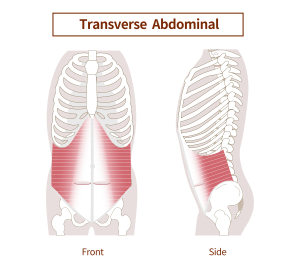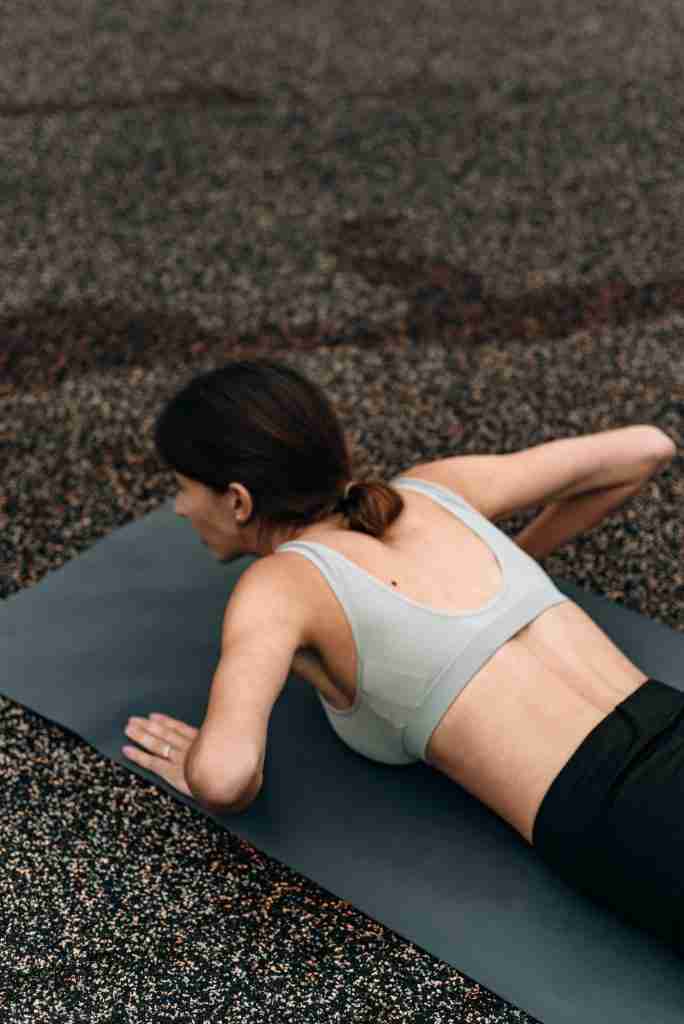
The birth of a child is one of the most significant experiences in a woman’s life. However, alongside the joy of welcoming a new family member, pregnancy can bring lasting changes to the body. Many women notice a protruding belly that can persist long after childbirth. This article discusses the causes of a protruding belly after pregnancy, diagnostic measures, and effective treatment options, including strengthening the Musculus Transversus, weight loss, and proper nutrition.
Causes of a Protruding Belly After Pregnancy
A protruding belly after pregnancy can have several causes:
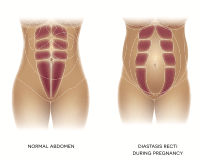
- Diastasis recti: The most common cause of a protruding belly is diastasis recti, a separation of the rectus abdominis muscles along the linea alba. This separation occurs due to the stretching of the abdominal muscles during pregnancy to make room for the growing baby.

- Weak deep Abdominal Muscles: The abdominal muscles, particularly the deep M.Transversus Abdominis, can become significantly stretched and weakened during pregnancy. Inadequate recovery of these muscles can lead to a protruding belly.
- Overweight: Weight gained during pregnancy can persist after childbirth and contribute to a protruding belly.
- Hormonal Changes: Hormonal changes during and after pregnancy can affect metabolism and fat distribution in the body, which can also lead to a protruding belly.
Diagnosis: Do You Have Diastasis Recti?
To determine if you have rectus diastasis, you can take the following steps:
- Self-Test: Lie on your back, bend your knees, and place your feet flat on the floor. Lift your head slightly and feel along the linea alba from the sternum to the pubic bone. Do you feel a gap or indentation? If this gap is wider than two fingers, rectus diastasis may be present.
- Professional Diagnosis: A doctor or physical therapist can provide a more precise diagnosis and determine the severity of the rectus diastasis.
Treatment Options for a Protruding Belly
1. Treatment of Rectus Diastasis
- Specific Exercises: Exercises that aim to gently bring the rectus abdominis muscles together are important for correcting rectus diastasis and restoring core stability. These include exercises like pelvic tilts and activating the Transversus Abdominis.
- Avoiding Strain: Avoid exercises and activities that heavily strain or stretch the abdominal muscles, such as crunches, sit-ups, and heavy lifting.
You can find out more about this in this article: Diastasis recti exercises
2. Strengthening the Musculus Transversus Abdominis
The Musculus Transversus Abdominis, the deepest abdominal muscle, acts like a natural corset that supports the internal organs and lower back. Strengthening this muscle is crucial for restoring a flat belly and a slim waist. Here are some exercises to strengthen this muscle:
- Drawing in the Navel: Consciously draw in your navel towards your spine several times a day. You can do this while sitting, lying down, or standing.

- Heel Slides: Lie on your back, bend your knees, and place your feet flat on the floor. Draw your navel towards your spine and alternately slide one leg forward while the other remains bent.
It is very important to first strengthen the Musculus Transversus until you can maintain a firm baseline tension. These exercises should be performed regularly over several weeks. Strengthening the deep transverse abdominal muscles, also known as corset muscles, ensures a flat belly and a slim waist.
You can find out more about why the corset muscle needs to be activated and trained after pregnancy here: Training the deep abdominal muscles
Protruding Belly After Pregnancy: Exercises
If the cause of your protruding belly is diastasis recti, check out the following article with exercises for diastasis recti: Diastasis Recti Exercises
Once you can maintain a firm core tension (deep abdominal muscles and pelvic floor), you can proceed with the following exercises:
It is important to avoid exercises that increase intra-abdominal pressure and to keep your abdominal and pelvic floor muscles tight during all exercises. Only perform the following exercises if you can already maintain firm abdominal and pelvic floor tension.
If you notice that your belly bulges out despite tension when lifting your head while lying on your back, then you cannot yet hold the abdominal tension sufficiently. In this case, stick to the exercises above! Anything else would be counterproductive.

- Pelvic Floor Exercises (Kegel Exercises)
- Instructions: Sit or lie comfortably. Contract the pelvic floor muscles as if you were stopping the flow of urine. Hold the contraction for a few seconds, then slowly release. Repeat 10-15 times.
.

- Bridges
- Instructions: Lie on your back with your knees bent and feet flat on the floor. Slowly lift your pelvis until your body forms a straight line, then lower it back down. Repeat 10-15 times.
.
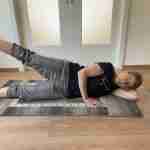
- Side Leg Lifts
- Instructions: Lie on your side, support your head with your arm, and slowly lift the top leg up and down. This exercise strengthens the side abdominal muscles and hips. Repeat 10-15 times per side.
.
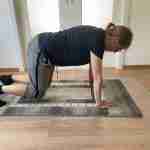
- Modified Plank
- Starting Position: Begin on your hands and knees, with your wrists directly under your shoulders and your knees under your hips. Lift your knees off the ground.
- Engage Core: Tighten your abdominal muscles by drawing your belly button toward your spine. Keep your back flat and your hips aligned with the rest of your body. Avoid sagging or arching your back.

- Dead bug: Lie on your back. Bend your knees at a 90-degree angle so that your shins are parallel to the floor.
- Engage Core: Tighten your abdominal muscles, pressing your lower back into the floor. This helps to stabilize your spine throughout the movement.
- Movement: Slowly lower your left leg toward the floor and then the right leg. Return to Start: Bring your right arm and left leg back to the starting position, maintaining control and keeping your core engaged.
.
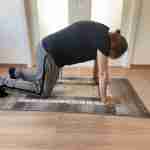
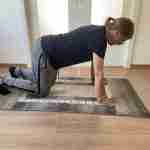
- Starting Position: Get on all fours, with your hands directly under your shoulders and knees under your hips. Cat Pose: Exhale, tuck your chin to your chest, and arch your back upward like a stretching cat. Cow Pose: Inhale, lift your head and tailbone upward, allowing your belly to sink and your back to arch downward.
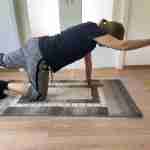
- Starting Position: Begin on your hands and knees, with your wrists directly under your shoulders and your knees under your hips. Keep your back flat and your head in a neutral position, looking down at the floor.
- Engage Core: Tighten your abdominal muscles to stabilize your spine. Make sure your back remains flat and your hips are level.
- Extend Opposite Arm and Leg: Simultaneously extend your right arm straight forward and your left leg straight back, forming a straight line from your fingertips to your toes. Keep your hips level and avoid rotating your torso.
3. Weight Loss
Weight loss can also help reduce a protruding belly. Here are some tips:

1. Set Realistic Goals
Set achievable and realistic goals to stay motivated and track your progress. Short-term and long-term goals that are specific, measurable, and attainable help maintain focus. For example, aim to lose 0.5-1 kg per week rather than expecting drastic changes immediately.
2. Prioritize a Balanced Diet
A balanced diet is crucial for weight loss. Incorporate a variety of nutrients into your meals, including plenty of vegetables, lean proteins, whole grains, and healthy fats. Avoid diets that exclude entire food groups, as these are often unsustainable and can lead to nutrient deficiencies.
3. Stay Hydrated
Drinking enough water is important for weight loss. Water helps boost your metabolism, cleanse your body of waste, and suppress your appetite. Drink a glass of water before each meal to control portions and reduce calorie intake.
4. Incorporate Regular Exercise
Combine cardio and strength training for effective weight loss. A mix of high-intensity interval training (HIIT) and strength training can help you burn more calories and build muscle, which in turn increases your metabolism. Aim for at least 150 minutes of moderate aerobic activity or 75 minutes of vigorous activity per week, along with muscle-strengthening exercises on two or more days per week.
5. Get Enough Sleep
Adequate sleep is often underestimated but is crucial for weight loss. Poor sleep can disrupt your metabolism, increase your appetite, and lead to weight gain. Aim for 7-9 hours of quality sleep each night to regulate your hunger hormones and support your weight loss goals.
6. Manage Stress
High stress levels can lead to emotional eating and weight gain. Practice stress management techniques such as mindfulness, meditation, deep breathing exercises, or hobbies that you enjoy. Managing stress can help prevent stress-related eating and promote a healthier lifestyle.
By integrating these tips into your daily routine, you can achieve your weight loss goals in a healthy and sustainable way. Remember, consistency and patience are key to long-term results.
4. Proper Nutrition
A balanced diet is essential for reducing belly fat and overall health. Here are some nutrition tips:

- Plenty of Vegetables and Fruits: These provide important vitamins, minerals, and fiber that support metabolism and increase satiety.
- Protein-Rich Foods: Protein helps build and maintain muscle and keeps you full for longer. It also stabilizes insulin levels, which helps burn fat. Good protein sources include lean meats, fish, eggs, dairy products, and plant-based proteins like beans and nuts.
- Healthy Fats: Incorporate healthy fats from sources like avocados, nuts, seeds, and olive oil into your diet.
- Avoid White Carbohydrates and Processed Foods: Reduce the consumption of sugar, white flour products, and heavily processed foods that often contain many empty calories.
For more tips on nutrition, have a look here: Nutrition and postpartum recovery
5. Hormonal Changes and Fat Distribution
During pregnancy, the body produces increased levels of hormones such as relaxin and progesterone. These hormones play a crucial role in preparing the body for childbirth and also affect fat distribution:
- Relaxin: This hormone loosens the connective tissue and ligaments throughout the body to make room for the growing baby and to widen the birth canal. While this process is necessary, the increased flexibility of the tissues also causes the abdominal muscles and the connective tissue (linea alba) to stretch and weaken.
- Progesterone: Progesterone helps maintain the uterine lining and relaxes the smooth muscles. It also promotes fat accumulation, especially in the abdominal area, to create energy reserves for pregnancy and breastfeeding. After childbirth, this fat often remains, contributing to a protruding belly.
- Estrogen: During pregnancy and breastfeeding, estrogen levels also change, affecting fat distribution in the body. Estrogen promotes fat storage in specific areas such as the abdomen, hips, and thighs.
Fat Distribution After Pregnancy
After childbirth, the fat distribution in the body slowly changes again. The fat accumulated in the abdominal area during pregnancy can be particularly stubborn due to the hormonal changes that persist for some time after childbirth.
- Visceral Fat: This is the fat that accumulates around the internal organs in the abdominal cavity. It is hormonally active and can lead to health problems such as insulin resistance and inflammation. During pregnancy, the body can store more visceral fat to protect the growing baby.
- Subcutaneous Fat: This is the fat that lies directly under the skin and is less metabolically active. It is more visible and contributes to the protruding belly.
Conclusion
A protruding belly after pregnancy can be caused by various factors, including diastasis recti, weak abdominal muscles, excess weight, and hormonal changes. Fortunately, there are many ways to address these challenges. No matter how long it has been since childbirth, you can always start doing something about a protruding belly. Through targeted exercises to strengthen the transversus abdominis muscle, correcting diastasis recti, weight loss, and a healthy diet, you can rebuild your abdominal muscles and stabilize your core. It is always advisable to consult a doctor or physical therapist before starting a new exercise program to determine the best approach.
For further reading, a guide with postpartum exercises is recommended.
The articles on health topics do not replace a visit to the doctor. You can find more information here.

Sonja ist Ernährungswissenschaftlerin und promovierte Epidemiologin mit langjähriger Erfahrung in der Gesundheitsforschung. Seit der Geburt ihrer beiden Kinder 2019 und 2023 beschäftigt sie sich intensiv mit dem Thema Rückbildung und der Thematik, wie man wieder einen gesunden und schönen Körper mit stabiler Mitte nach der Schwangerschaft bekommen kann. Sie möchte Euch helfen, nach der Schwangerschaft wieder fit zu werden!
